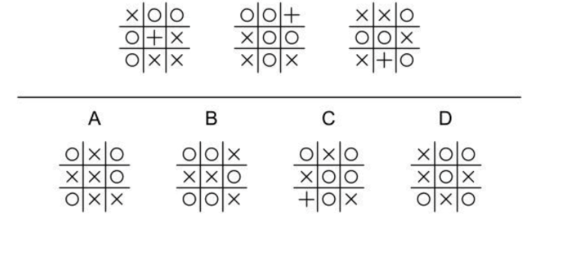The 8th-grade CogAT represents the culmination of a student’s skill development throughout their early school career. The exam assesses a student’s ability to solve quantitative, multi-step math problems that demand focus and the use of a process of elimination. Additionally, subtests such as “Verbal Classification” require that the student utilizes a “built-in” thesaurus to analyze relationships between words. Activities such as reading, vocabulary flashcards, and exposure to conversation are all beneficial for verbal subtests.
The Non-Verbal “Figure Matrices” Subtest also evaluates a student’s capacity to discern relationships but focuses on figures, not words. This subtest necessitates that the student actively practice visual imagery while identifying subtle changes among a series of items. Practicing these sets of questions that we offer on our site is an excellent way for your child to gain confidence with this section. Below, you’ll find a series of sample questions that closely resemble those your child will encounter on the 8th-grade CogAT.
1) Quantitative Battery: Number Puzzles
CogAT Number puzzles are all about testing your math skills. Moreover, these puzzles will challenge the student to work with numbers in different ways. Specifically, the type of questions involves adding, subtracting, multiplying, or dividing the numbers in a sequence. Consequently, the student is required to figure out what math operations to use and solve the puzzle.
Example #1:
In this section, you will be given a mathematical equation. Choose the answer that should replace the ? or the § symbol.
(§ + 2)2 = 16
a. 1 b. 2 c. 3 d. 4 e. 5
2) Non-Verbal Battery: Figure Classification
CogAT Figure Classification actively assesses a student’s abstract reasoning abilities by requiring them to identify patterns, relationships, and similarities among various geometric figures.
In the figure classification subtest, the student examines three figures on the left, which share a specific relationship. Then, the student actively selects an answer on the right that mirrors the relationship found in the initial three figures. As the questions become more challenging, the three figures shift to the top, and the answer choices appear below, but the reasoning remains consistent.
Example #2:
Parent, say to your child: The first 3 figures on the left (or on top) relate to each other in some way. Find a figure to the right of the line (or, below the line) that goes with the first 3 figures in exactly the same way.


3) Verbal Battery: Verbal Analogy
CogAT Verbal Analogy actively evaluates a student’s verbal reasoning abilities by requiring them to recognize and understand relationships between words. These questions encompass various types of relationships, such as synonyms, antonyms, part-whole relationships, and more.
Example #3:
The first two words in the sentences below go together in a certain way. Choose the answer that goes with the third word in the sentence in the same way that the first and second words go together.
Cardiology is to heart as theology is to _________.
A. mathematics B. sun C. engineering D. religion E. culture
4) Quantitative Battery: Number Series
CogAT Number Series questions actively evaluate a student’s ability to recognize and extend numerical patterns or sequences. Furthermore, they serve to assess a student’s critical thinking skills, their capacity to identify mathematical patterns, and their application of logical reasoning to solve numerical problems. Additionally, these questions may exhibit varying levels of complexity, with more challenging sequences incorporating multiple operations or intricate patterns.
Example #4:
Look at the numbers in each row below. There is a rule that governs the order in which the numbers occur in the series. Figure out the rule and then choose the number that comes next from the answer choices below.
121 100 81 64 49 _____
A. 25 B. 36 C. 41 D. 44 E. 45
5) Non-Verbal Battery: Paper Folding
CogAT Paper Folding questions actively evaluate a student’s spatial reasoning abilities, mental imagery, and understanding of geometric transformations. Moreover, these questions may vary in complexity, with more advanced ones incorporating multiple folds and intricate patterns.
Example #5:
On the top row, you will see how a square piece of paper is folded sometimes once, sometimes twice, sometimes three times. Holes are then punched after the paper has been folded. Choose the answer in the second row that shows how the folded piece of paper would look after it is unfolded.
Answers:
1) b
2) C – A + sign in each figure
3) D
4) B – square of a whole number
5) B
Getting your child ready for the CogAT? Don’t search any further than TestingMom Online Tutoring – your trusted ally for success! We fully understand the critical role cognitive development plays, especially for older students striving for exceptional performance. Our team of experienced tutors specializes in CogAT preparation and is genuinely excited to provide the personalized guidance and support your child truly merits. No need to wait – schedule a FREE consultation call with one of our experts today through TestingMom Online Tutoring and grant your child the advantage they’ve rightfully earned!
